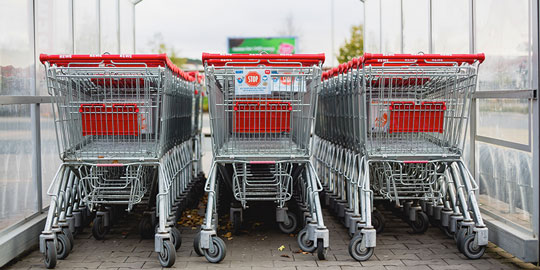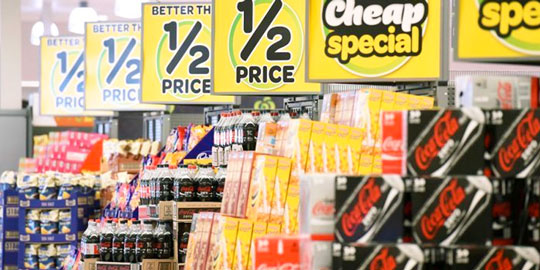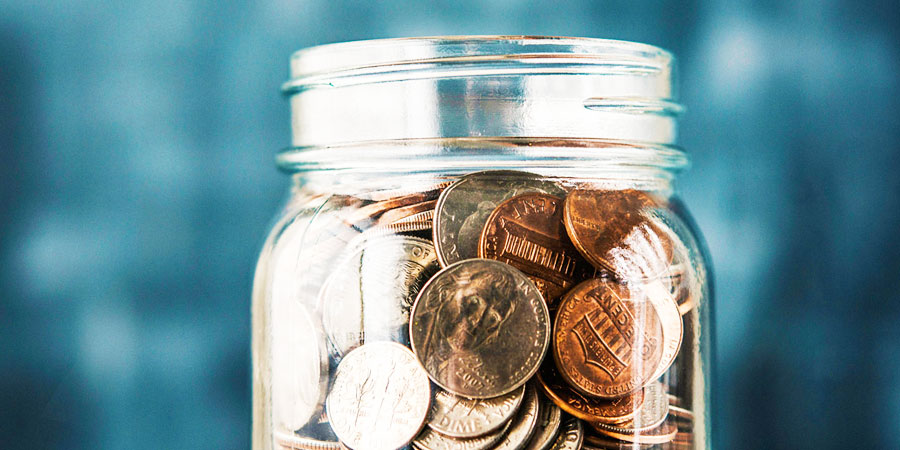The cost of groceries in Australia is, quite frankly, ridiculous. Food is the second biggest expense that most Aussie’s will have to deal with in their weekly budget after housing. And while it’s super easy to tell someone that they need to cut back if they want to save a few dollars, it isn’t always clear on how. But the good news it is possible to cut back and save money on your grocery bill.
In this post, I’ll go over:
- How much money you should be spending on food each week.
- What you should be buying at the supermarket.
- Tips on reducing your current grocery bill.
How Much Should You Be Spending on Food Each Week?
Are you spending too much on food? Maybe you’re super frugal and know how to get your grocery bill under $100?
Let’s have a look at what the average Aussie spends on their weekly shop and the ways that the super sneaky supermarkets are making us spend more.
What Does The Average Australian Spend on Groceries?
Before we look at ways to start cutting back on our food budget, I thought it would be useful to find out how much the person next door is spending each week. It will provide a good benchmark to evaluate how our shopping habits compare to others.
According to ASIC’s Moneysmart website, the average weekly spend for food and drinks (excluding alcohol) ranged from:
- $122 for a single person under 35,
- $239 for a couple with no kids, and
- between $282 and $332 with families with kids (depending on the number and ages of the little ones).
So if you’re in this range your spending is considered average. But who wants to be average. Amirite?
It’s worth noting those averages are from all over Australia. There are certain states where food is more expensive than others. For example, you’ll pay more in the Northern Territory than you will in Tasmania.
Why Grocery Budgets Blow-out
The main reason that our grocery budgets often blow out is due to the sneaky supermarket tactics that are designed to make you spend more money in the store. Supermarkets spend big bucks designing their stores and product layouts so that people buy more than they need.
They’ll position certain foods at different levels based on who is likely to be attracted to it. Sugary over-processed food is usually at kid eye level, while the brands and products which give them the biggest profits are at adult eye level.
The music and lighting are carefully chosen to make us slip into either a calm state or an excited state, depending on the time of day (notice that they play more upbeat music late in the day as opposed to a softer mid-morning).
And of course, the food staples that people need more often (milk/bread/etc) are at the back of the store so you have to walk past brightly colored temptations to get to them.
ACTION: Take note of the music and lighting when you go. See if it changes at different times of the day/week.
Become Mindful of Your Weekly Shop
So how do you become savvier and mindful to their tactics?
Well, just being aware of what they do is the first step. If you find yourself mindlessly picking up something that you hadn’t even thought of five minutes ago, then it’s likely that you’ve been suckered into something extra. Put it back on the shelf.
Sure it might look delicious and you’re already thinking about what it’ll taste like, but if you didn’t want it a few minutes ago, you’ll be perfectly fine without it now.
The second step to becoming more mindful is to have a goal in mind. Even just a monetary goal is fine – say you’ll only spend $50 or $100 or whatever and add up anything you put in the trolley. I usually round up to the next dollar so I’m not dealing with cents in my head. $1.75 item becomes $2 when I’m adding on the go.
ACTION: If you pick something up, ask yourself if you really need it before putting it into the trolley. Once it goes into the trolley you’re unlikely to take it back out.

What To Buy at the Supermarket?
Okay, so now that we know the tricks that are out to part us with our money, what are we going to buy?
There are many ways to go about this, including meal planning and creating shopping lists (I’ll talk about this in a sec), but first, let’s discover some budget-friendly meals to add to our repertoire.
What Are Some Good Budget Meals?
If you want the cheapest and most nutritious foods that you can get then it’s worth looking at the following:
- Wholegrain Rice / Pasta – Both pasta and rice (preferably wholegrain) can be added as side dishes or as part of the full meal itself. You could make fried rice with frozen veggies, add pasta to soup to bulk it up or pour homemade pasta sauce on it.
- Frozen Vegetables – Frozen veggies are a great way to have a quick side dish or add to soups, stews, fried rice, veggie pies and so on. Our family particularly likes corn kernels and green peas.
- Fresh Vegetables – The basic fresh vegetables that you should stock up on are potatoes (cheap and versatile), carrots, and broccoli. These aren’t the trendiest of all the veggies but they can be incorporated into many dishes.
- Fresh Fruit – The fruit to go for are apples, pears, oranges, and bananas. Again, not the trendiest of fruit, but simple is usually budget friendly. Pears especially can be frugal and they make a great puree.
ACTION: Start thinking about ways to bulk out your meals. Salads, pasta, bread etc are all inexpensive ways to add to your main meal.
Can You Eat Healthy On A Budget?
You can eat healthy on a budget, but it’ll take some planning.
Sticking to the fruit and veg section, lean meats, and yogurts aisles means that you will avoid the overly processed food in the middle aisles that are full of sugar, salt, and fillers that do nothing but increase your waistline.
Not all specialty diets work when you’re on a budget though.
If you’re on a Ketogenic or Paleo diet then you’ll find that these are far more expensive than, say, a Mediterranean diet. That’s because these specific diets eliminate the high carbohydrate foods such as bread and pasta’s that are less expensive, and instead promote organic and grass-fed foods—all of which can cost more.
The trick then is to make sure you know when your supermarket marks down its meat and fish, then buy and when you get home portion off what you plan to use in the next days and freeze the rest.
ACTION: If you’re on a diet, don’t be afraid of making swaps to less expensive alternatives. Try cheaper cuts of meat or less expensive vegetables than those in the recipe.
Bulk Buy Items When They Are On Half Price Sale
Both Coles and Woolworths currently have half price sales where some items within the store are 50% off.
Usually, these prices change on a Wednesday and run the full week to the next Tuesday.
Generally, most branded products will come on a half price special at some stage during a two month period. Some more often than others.
They rarely have healthy food in these sales, but they do have other household items that you need on a regular basis like shampoo and conditioner, laundry detergents, household cleaners, toilet paper and more.
If one of your regular staples comes up on a half price, make sure you bulk buy it. Buy enough of the product that you think you’ll need within a two month period so you don’t run out until the next time it goes back to half.
ACTION: Make a habit of visiting the website of your nearest supermarket on the regular to see which products are on half-price special that week. Incorporate your meal plan around those items.

More Tips on How To Reduce Your Grocery Bill
The other tips I have are the usual ones that you read everywhere but are no less important if you’re trying to reduce your grocery bill. In fact, just implementing a few of them will reduce your spending even if you do nothing else.
Take Fewer Trips to the Store
Physically going to the store less than you currently do is often enough to cut back when you aren’t even trying to.
Roy Morgan Research revealed that a weekly shop is no longer that common. The average Aussie goes to the supermarket multiple times per week. Most of the reasons people said they shop more often is convenience and better freshness.
But are we making excuses?
Our parents and grandparent managed to do a weekly shop with no problems by planning meals ahead of time. They would have a similar menu every single week rarely deviating from what worked.
I’m not saying we need to go back to meat and three veg meals every night, but by challenging yourself to go to the store less, means you will start to shop your own pantry and freezer which will lead to less food wastage and more savings overall.
ACTION: If you’re a regular shopper, challenge yourself to go to the supermarket one less time this week. Try and work your way up to once per week.
Create a Detailed Shopping List
Which of course means that spending one day a week coming up with a weekly meal plan will allow you to go less.
It also allows you to pre-plan meals that can use similar ingredients. For example, one night you might have a roasted chicken with vegetables, and the next night you can use any leftover chicken or veggies in wraps or tacos.
Meal planning doesn’t have to take a lot of time, and it can if done well, save you time as well as money.
All you need to do is make a list of everything that you and your family will eat for breakfast, lunch, dinner, and snacks for the week, and then create your shopping list from that.
Also, bulk cooking meals can help you even further, as you can cook double than you need for the night and freeze the rest for another night that week or next.
ACTION: Create a quick meal plan of the meals you’re going to have this week and then write down which ingredients you’ll need to purchase to make it happen. Freeze leftovers for the following week.
Understand Unit Pricing
The last thing I’m going to talk about in this blog post is how to understand unit pricing. Using this tactic is another simple way to save.
Both Coles and Woolworths will display the unit price on its price display ticket – usually in smaller font at the bottom.
![]() Unit pricing is a better way to decide on the cost of something. Sometimes the more expensive ticket price can actually be a less expensive item overall because of the volume of the product. Basically, you might get more product making it cheaper.
Unit pricing is a better way to decide on the cost of something. Sometimes the more expensive ticket price can actually be a less expensive item overall because of the volume of the product. Basically, you might get more product making it cheaper.
This can be a good way to choose between products if you’re not sure which one is better value.
Be careful of this in the fresh food section too. You’ll often see that packaged apples are more expensive than loose apples (and so on). Just look at the price per kilo to find this out.
ACTION: Get used to reading the unit price on the ticketed item rather than the actual price. Compare similar products when deciding what to buy.
Main Photo Credit: Photo by Joshua Rawson-Harris on Unsplash
Trolley Photo: Markus Spiske



